Lower Silesian Voivodeship, or Lower Silesia Province[4] (Polish: Województwo dolnośląskie, [vɔjɛˈvut͡stfɔ dɔlnɔˈɕlɔw̃skjɛ] ⓘ), in southwestern Poland, is one of the 16 voivodeships (provinces) into which Poland is divided. The voivodeship was created on 1 January 1999 out of the former Wrocław, Legnica, Wałbrzych and Jelenia Góra Voivodeships, following the Polish local government reforms adopted in 1998. It covers an area of 19,946 square kilometres (7,701 sq mi), and as of 2019 has a total population of 2,899,986.
It is one of the wealthiest provinces in Poland as natural resources such as copper, brown coal and rock materials are widely present.[5]
Its capital and largest city is Wrocław, situated on the Oder River. The voivodeship is host to many castles and palaces. For this reason tourism is a large part of this region's economy.
History
In the past 1,200 years, the region has been part of Great Moravia, the Medieval Kingdom of Poland, the Crown of Bohemia, Habsburg monarchy (Austria), Prussia, the German Empire, and modern Poland after 1945.
Silesian tribes settled the lands at the end of the first millennium after the Migration Period. During the period of Germania Slavica, the region became part of Great Moravia under Svatopluk I of Moravia. Mieszko I brought the various existing Silesian duchies under the rule of the Piast dynasty and they became the Duchy of Silesia. It was again divided into small realms reigned by Silesian branches of Piast princes after the testament of Bolesław III Wrymouth in 1138. With the Ostsiedlung, the cultural and ethnic Germanic influence grew with an influx of immigrants from the German-speaking areas of the Holy Roman Empire, of which Silesia was a direct part until the 1330s when it was subjugated to the Kingdom of Bohemia, then together with it became part of the Habsburg monarchy (1526), then the Kingdom of Prussia (1742/44), and subsequently the German Empire (1871). In 1945, Lower Silesia was made part of Poland as agreed at the post-war Potsdam Conference. As a consequence, Lower Silesia suffered a nearly total loss of its pre-war population between 1945 and 1950. Polish citizens dispossessed by the Soviets were then settled in the now emptied lands.[6]
Lower Silesia was, during the early medieval era, one of Poland's cultural centers. The Book of Henryków (1273), which contains the earliest known sentence written in the Polish language, as well as a document which contains the oldest printed text in Polish, were both created within it.[7] Złotoryja, Poland's first town, was granted municipal privileges according to German Magdeburg rights by Henry the Bearded. Over the centuries, Lower Silesia has experienced several epochal events such as the Protestant Reformation, the Silesian Wars, industrialisation and the two World Wars.
Geography
Although much of the region is relatively low-lying, Lower Silesia includes the Sudeten Foreland, as well as part of the Sudetes mountain range, that runs along the Polish/Czech border. Ski resorts in the Lower Silesian Voivodeship include Karpacz and Szklarska Poręba in the Karkonosze mountains.
The voivodeship has a number of mineral springs and is host to a large number of spa towns. The highest point in the voivodeship is Mount Śnieżka (1603 m above sea level) while the lowest point is located in the Oder River Valley (69 m above sea level).[8]
Lower Silesian Voivodeship is bordered by Lubusz Voivodeship to the north-west, Greater Poland Voivodeship to the north-east, Opole Voivodeship to the south-east, the Czech Republic (Hradec Králové Region, Liberec Region, Olomouc Region and Pardubice Region) to the south, and Germany (Saxony) to the west.
Transport
The Copernicus Airport Wrocław serves as an international and domestic airport.
Wrocław Główny is the largest railway station in Poland, serving an average of 21.2 million passengers annually. It offers the domestic and international connections of various carriers.
The A4 motorway,[9] A8 motorway, A18 motorway and S3 Expressway, S5 Expressway, S8 Expressway also run through the voivodeship.
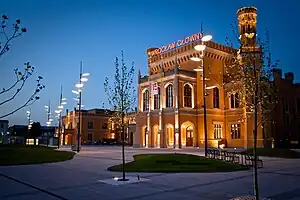 Wrocław Główny railway station is a major railway hub in the region
Wrocław Główny railway station is a major railway hub in the region Koleje Dolnośląskie train at Wrocław Główny
Koleje Dolnośląskie train at Wrocław Główny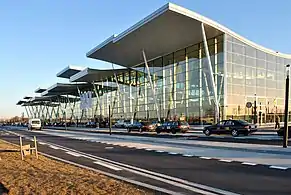
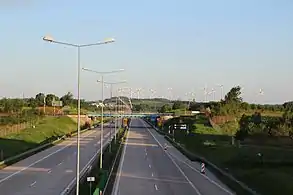
.jpg.webp) The viaduct in Lewin Kłodzki, on the railway line No. 309
The viaduct in Lewin Kłodzki, on the railway line No. 309
Tourism

Tourism is important for Lower Silesian Voivodeship. There are 99 castles and hundreds of palaces. A lot are located Jelenia Góra Valley.
Wrocław being the largest city in the voivodeship has many sights and attractions, including the Market Square, the Cathedral Island and Wrocław's dwarfs. The Festival of Good Beer is held every year of June.
The annual international Chopin Festival is held in the Fryderyk Chopin Theatre in the town of Duszniki-Zdrój. Other major attraction of the town is the Museum of Papermaking, established in a 17th-century paper mill.
Śnieżka is the highest peak of the Lower Silesian Voivodeship and the whole of the Sudetes.
- Castles and palaces (examples)

_ID_593146.jpg.webp) Piast Castle in Legnica
Piast Castle in Legnica2a.jpg.webp)
.jpg.webp)
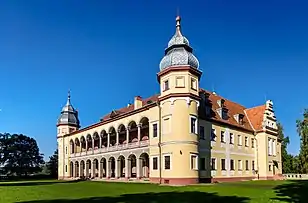 Krobielowice Palace
Krobielowice Palace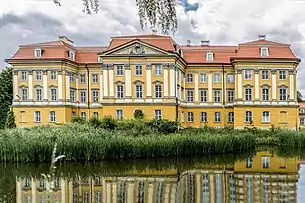 Radomierzyce Palace
Radomierzyce Palace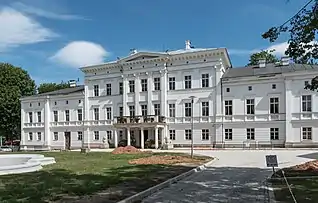 Jedlinka Palace in Jedlina-Zdrój
Jedlinka Palace in Jedlina-Zdrój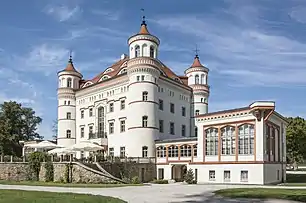 Wojanów Palace
Wojanów Palace
- Burial sites of Polish monarchs and consorts


 Holy Cross Church, whose scholastic was Nicolaus Copernicus
Holy Cross Church, whose scholastic was Nicolaus Copernicus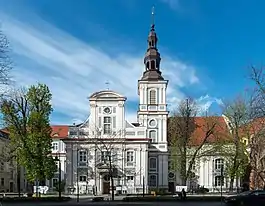 Church of St. Clare and Hedwig church, Wrocław
Church of St. Clare and Hedwig church, Wrocław
Protected areas

Protected areas in Lower Silesian Voivodeship:
- 2 National Parks
- Karkonosze National Park (part of a UNESCO trans-border biosphere reserve)
- Table Mountains National Park
- 12 Landscape Parks
- Barycz Valley Landscape Park (partly in Greater Poland Voivodeship)
- Bóbr Valley Landscape Park
- Bystrzyca Valley Landscape Park
- Chełmy Landscape Park
- Jezierzyca Valley Landscape Park
- Książ Landscape Park
- Owl Mountains Landscape Park
- Przemków Landscape Park
- Rudawy Landscape Park
- Ślęża Landscape Park
- Śnieżnik Landscape Park
- Sudety Wałbrzyskie Landscape Park
- 67 Nature reserves
- 20 protected landscape areas
- 3100 Natural monuments
- 114 Ecological usages
- 15 Teams nature and landscape
and many areas of Natura 2000 network.
Tourist routes
- The Main Trail Sudetes long-distance mountain trail
- The Piast Castles Trail
- Trail around Wrocław
- Cistercian trail
- The trail of the Valley of Palaces and Gardens of the Jelenia Góra Valley
- Lower Silesian Rout of St. James
- Sudetes Rout of St. James
- Camino de Santiago - Via Regia
- The Trail of Extinct Volcanoes on the Kaczawskie Foothills
- Lower Silesian Beer and Wine Trail[10]
- EuroVelo 9
- Lower Silesian Bicycle Highway
- Bicycles S5 (Wrocław – Poznań)
- Blue Velo - The Odra River Bicycle Route
Economy

The gross domestic product (GDP) of the province was 41.1 billion euro in 2018, accounting for 8.3% of the Polish economic output. GDP per capita adjusted for purchasing power was €23,400 or 78% of the EU27 average in the same year. The GDP per employee was 85% of the EU average. Lower Silesia Voivodeship is the province with the second highest GDP per capita in Poland.[11]
| Lower Silesian Voivodeship | GDP per capita | Poland | GDP per capita |
|---|---|---|---|
| 2000 | $10 440 (+2.8%) | 2000 | $10 140 (+4.0%) |
| 2005 | $13 060 (+4.9%) | 2005 | $12 600 (+3.5%) |
| 2006 | $13 700 (+7.3%) | 2006 | $13 020 (+6.2%) |
| 2007 | $14 980 (+9.5%) | 2007 | $13 760 (+6.5%) |
| 2008 | $16 030 (+7.2%) | 2008 | $14 450 (+5.0%) |
| 2009 | $16 350 (+2.0%) | 2009 | $14 720 (+1.9%) |
Cities and towns
The voivodeship contains 8 cities and 83 towns. The cities, governed by a city mayor (Polish: prezydent miasta), are listed below in descending order of population (as of 2019):[1]
Cities
- Wrocław
- Wałbrzych city county (111,896)
- Legnica city county (99,486)
- Jelenia Góra city county (79,200)
- Lubin (72,428)
- Głogów (66,120)
- Świdnica (56.803)
- Bolesławiec (38,852)
Towns
- Oleśnica (37,169)
- Dzierżoniów (33,239)
- Oława (33,029)
- Zgorzelec (30,374)
- Bielawa (29,971)
- Kłodzko (26,845)
- Jawor (22,890)
- Świebodzice (22,793)
- Polkowice (22,480)
- Nowa Ruda (22,067)
- Lubań (21,087)
- Kamienna Góra (19,010)
- Bogatynia (17,436)
- Strzegom (16,106)
- Jelcz-Laskowice (15,803)
- Złotoryja (15,564)
- Boguszów-Gorce (15,368)
- Ząbkowice Śląskie (15,004)
- Chojnów (13,355)
- Trzebnica (13,331)
- Brzeg Dolny (12,511)
- Strzelin (12,460)
- Wołów (12,373)
- Góra (11,797)
- Milicz (11,304)
- Kowary (10,869)
- Syców (10,397)
- Bystrzyca Kłodzka (10,134)
- Kudowa-Zdrój (9,892)
- Środa Śląska (9,516)
- Oborniki Śląskie (9,099)
- Lwówek Śląski (8,869)
- Ziębice (8,708)
- Siechnice (8,113)
- Chocianów (7,892)
- Pieszyce (7,123)
- Kąty Wrocławskie (6,994)
- Sobótka (6,981)
- Żarów (6,719)
- Twardogóra (6,692)
- Gryfów Śląski (6,636)
- Szklarska Poręba (6,557)
- Żmigród (6,435)
- Piława Górna (6,412)
- Głuszyca (6,361)
- Polanica-Zdrój (6,324)
- Piechowice (6,194)
- Przemków (6,107)
- Lubawka (6,028)
- Pieńsk (5,828)
- Stronie Śląskie (5,709)
- Szczawno-Zdrój (5,608)
- Ścinawa (5,582)
- Lądek-Zdrój (5,572)
- Szczytna (5,141)
- Jaworzyna Śląska (5,124)
- Bolków (4,990)
- Bierutów (4,867)
- Jedlina-Zdrój (4,828)
- Karpacz (4,593)
- Duszniki-Zdrój (4,584)
- Leśna (4,439)
- Olszyna (4,348)
- Nowogrodziec (4,243)
- Zawidów (4,180)
- Świeradów-Zdrój (4,147)
- Mieroszów (4,070)
- Mirsk (3,886)
- Wojcieszów (3,668)
- Prochowice (3,602)
- Niemcza (2,965)
- Węgliniec (2,846)
- Złoty Stok (2,758)
- Wąsosz (2,662)
- Międzylesie (2,575)
- Bardo (2,562)
- Radków (2,406)
- Międzybórz (2,341)
- Świerzawa (2,286)
- Prusice (2,243)
- Wiązów (2,241)
- Lubomierz (1,979)
- Wleń (1,759)
Administrative division

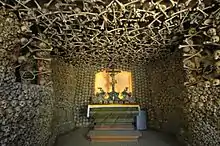

Lower Silesian Voivodeship is divided into 30 counties (powiaty), four of which are city counties. These are further divided into 169 gminy.
Lower Silesia is divided into three additional delegation districts governed by the provincial government, with Wrocław serving as the capital of the administrative region:[12]

- Wałbrzych Delegation District - powiaty of Świdnica, Kłodzko, Ząbkowice Śląskie, Dzierżoniów.
- Jelenia Góra Delegation District - powiaty of Boleslawiec, Kamienna Góra, Luban, Lwówek Śląski, Zgorzelec.
The counties are listed in the following table (ordering within categories is by decreasing population).
Governors
| Name | Period |
|---|---|
| Witold Krochmal | 4 January 1999 – 22 October 2001 |
| Ryszard Nawrat | 22 October 2001 – 21 March 2003 |
| Stanisław Łopatowski | 31 March 2003 – 21 December 2005 |
| Krzysztof Grzelczyk | 21 December 2005 – 29 November 2007 |
| Rafał Jurkowlaniec | 29 November 2007 – 1 December 2010 |
| Aleksander Skorupa | 28 December 2010 – 11 March 2014 |
| Tomasz Smolarz | 12 March 2014 – 8 December 2015 |
| Paweł Hreniak | 8 December 2015 – 11 November 2019 |
| Jarosław Obremski | 5 December 2019 – 22 December 2023 |
| Maciej Awiżeń | 22 December 2023 – |
See also
References
- 1 2 "Population. Size and structure and vital statistics in Poland by territorial division in 2019. As of 30th June". stat.gov.pl. Statistics Poland. 15 October 2019. Retrieved 14 February 2020.
- ↑ "EU regions by GDP, Eurostat". Retrieved 18 September 2023.
- ↑ "Sub-national HDI - Subnational HDI - Global Data Lab". globaldatalab.org. Radboud University Nijmegen. Retrieved 13 December 2021.
- ↑ Arkadiusz Belczyk,Tłumaczenie polskich nazw geograficznych na język angielski Archived 3 March 2016 at the Wayback Machine [Translation of Polish Geographical Names into English], 2002–2006.
- ↑ "Past and Present Regions of Poland – Lower Silesia". Archived from the original on 20 July 2016. Retrieved 10 March 2017.
- ↑ "Kresowianie nie mieli wyboru, musieli jechać na zachód, interview with Professor Grzegorz Hryciuk,". wyborcza.pl (in Polish). 20 December 2010. Retrieved 27 December 2023.
- ↑ Allen Kent, Harold Lancour, Jay E. Daily, Encyclopedia of Library and Information Science, CRC Press, 1978, pg. 3,
- ↑ "Położenie". dolnyslask.poland.com (in Polish). Retrieved 27 December 2023.
- ↑ "Dolnośląskie (Lower Silesia)". paih.gov.pl. Retrieved 27 December 2023.
- ↑ "Dolnośląski Szlak Piwa i Wina".
- ↑ "Regional GDP per capita ranged from 30% to 263% of the EU average in 2018". Eurostat.
- ↑ Internet, JSK. "Delegatury Urzędu – Dolnośląski Urząd Wojewódzki". Archived from the original on 31 May 2013. Retrieved 10 March 2017.
External links
- Województwo Dolnośląskie Official website
- Website of the government of Lower Silesia
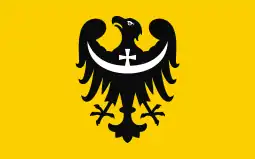
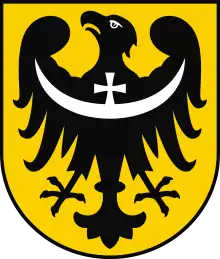
.svg.png.webp)


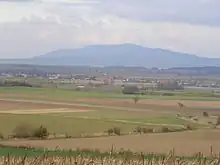
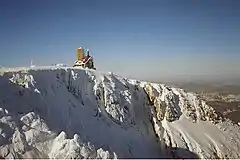


.JPG.webp)
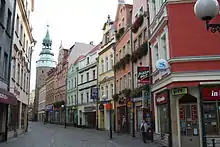
.jpg.webp)



.jpg.webp)